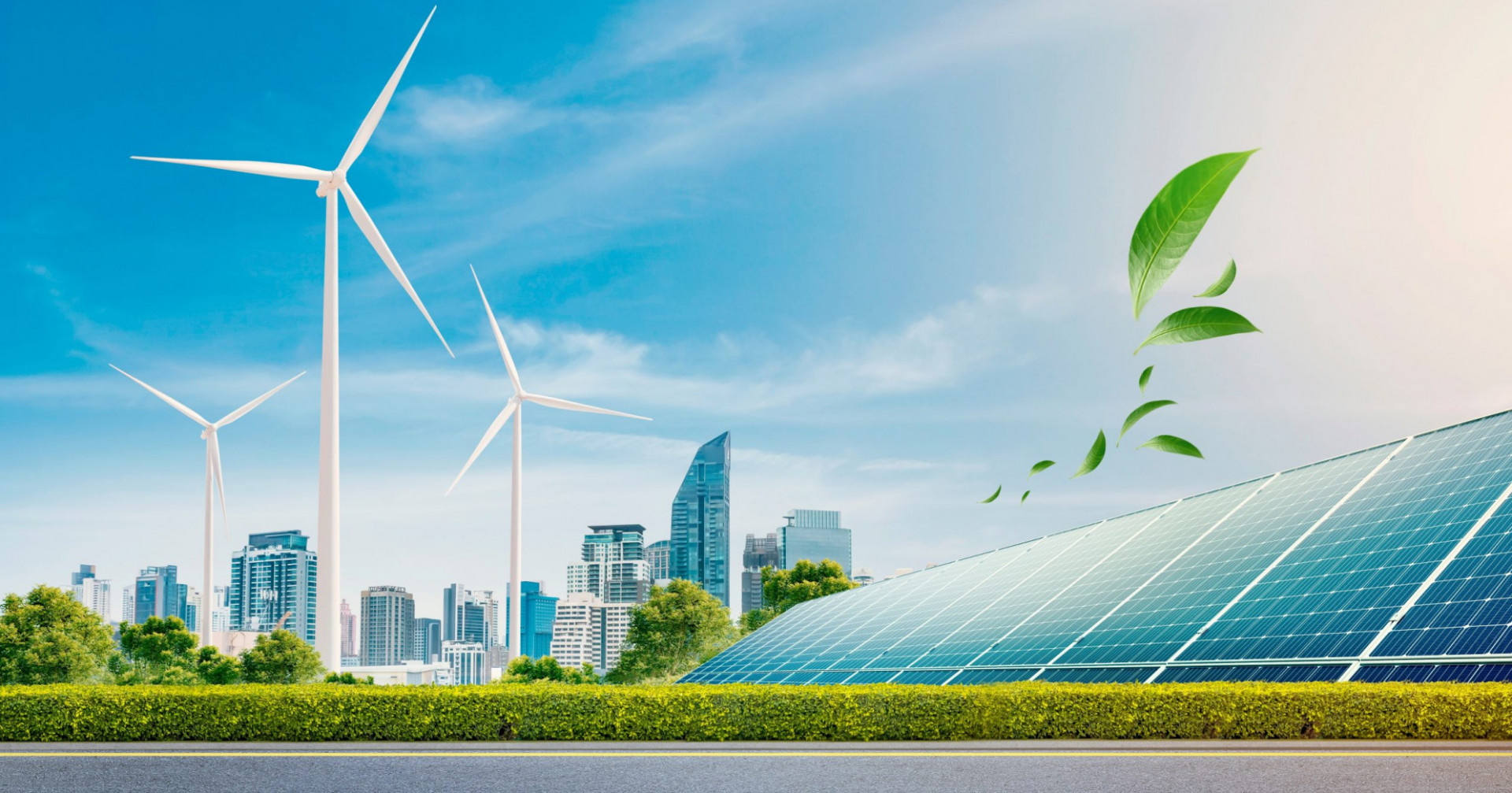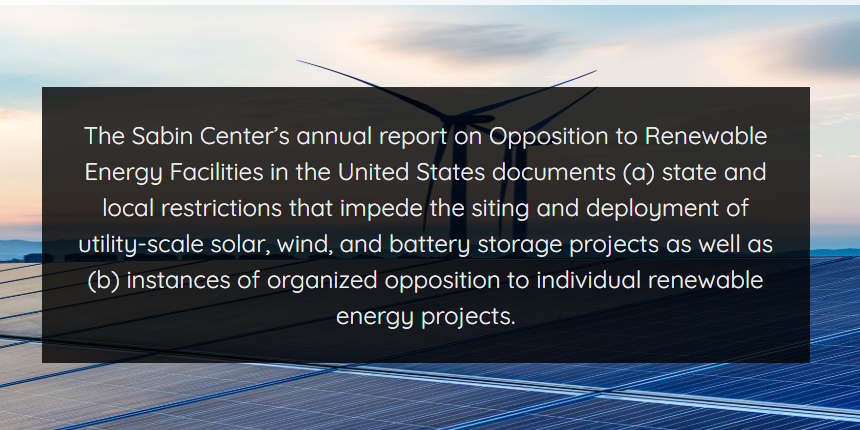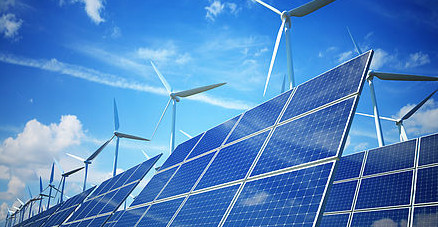Renewable Energy Legal Defense Initiative
The Renewable Energy Legal Defense Initiative (RELDI) works with local residents, community groups, and public interest organizations to advance renewable energy projects, including utility- and community-scale wind and solar projects.
Sample RELDI Matters
Please contact us if you are an attorney interested in working on a matter with RELDI or you are aware of controversies related to the siting of renewable energy projects that might benefit from legal counsel.
Year
- 2024-2025
State(s)
- Michigan
Description
- Defending Renewable Energy Siting Regulations in Michigan: In December 2024 and February 2025, RELDI submitted two amicus briefs (see here and here) on behalf of landowners in a case before the Michigan Court of Appeals, in which several townships and counties were challenging a state Public Service Commission order providing interpretive guidance on the implementation of a new state siting law. The briefs submitted by the landowners explained the need for, and legality of, the Commission order. The litigation remains pending.
Year
- 2024-2025
State(s)
- Ohio
Description
- Supporting the Eastern Cottontail Solar Project in Fairfield County, Ohio: In November 2024, RELDI intervened and submitted briefs (see here and here) in a proceeding before the Ohio Power Siting Board (OPSB) on behalf of two landowners who support the 220 megawatt Eastern Cottontail Solar Project. In October 2025, the OPSB approved the project.
Year
- 2024
State(s)
- Rhode Island and Connecticut
Description
- Supporting the Revolution Wind Project in Rhode Island and Connecticut: In 2024, RELDI submitted amicus briefs (see here and here) on behalf of Climate Action Rhode Island in support of the 704 megawatt offshore wind project, Revolution Wind. The motions challenging the approval of the permit for the project were denied and the litigation remains pending in the United States District Court for the District of Columbia. See Green Oceans, et al v. U.S. Dept. of Interior, et al, Case No. 1:24-cv-00141-RCL (D.D.C. 2024).
Year
- 2024-2025
State(s)
- Ohio
Description
- Supporting the Frasier Solar Project in Knox County, Ohio: In 2024 and 2025, RELDI worked with a landowner in Kent County, Ohio, who supported development of the 120 megawatt Frasier Solar Project. RELDI intervened in, and submitted briefs (see here and here), in support of the project in a proceeding before the Ohio Power Siting Board (OPSB). The OPSB ultimately approved the project. In October 2025, the opponents appealed the OPSB’s decision to the Ohio Supreme Court where the matter remains pending.
Year
- 2023
State(s)
- Ohio
Description
- Supporting the Oak Run Solar Project in Madison County, Ohio: In 2023, RELDI intervened in a proceeding before the Ohio Power Siting Board (OPSB) on behalf of a neighbor of the 11,000 megawatt Oak Run Solar project who supports it. After the OPSB approved the project, RELDI opposed a rehearing application by local government intervenors. RELDI also later submitted an amicus brief in support of the OPSB’s approval of the project in an Ohio Supreme Court case. The decision of the Ohio Supreme Court remains pending.
Year
- 2022
State(s)
- New York
Description
- Defending Renewable Energy Siting Regulations in New York State: In December 2022, RELDI filed an amicus brief in support of New York State, in its defense of regulations establishing a streamlined siting process for certain renewable energy facilities, which were challenged by several towns and advocacy groups. The court upheld the regulations.
Year
- 2022
State(s)
- Ohio
Description
- Supporting the Emerson Creek Wind Farm in Erie and Huron Counties, Ohio: In June 2022, RELDI filed an amicus brief in the Ohio Supreme Court in a case challenging the Ohio Power Siting Board’s approval of the 200 megawatt Emerson Creek Wind Farm. The Supreme Court affirmed the Board’s decision.
Year
- 2021
State(s)
- Michigan
Description
- Pushing Back Against a Restrictive Solar Ordinance in Ovid Township, Michigan: RELDI assisted local landowners in writing a letter to the Board of Ovid Township, Michigan, which was considering adopting a restrictive solar energy ordinance. The letter noted the proposed ordinance's legal vulnerabilities and inconsistencies with public policy, and urged the Board to reject the ordinance. The Board adopted a less restrictive ordinance allowing solar energy projects to go forward.
Year
- 2021
State(s)
- Iowa
Description
- Wind Farm in Madison County, Iowa: In 2021, RELDI supported Citizens for Agricultural Rights and Renewable Energy (CARRE), a community group in Madison County, Iowa, that advocates for wind energy projects, including writing a letter to the Madison County Board of Supervisors on behalf of CARRE advocating for a wind energy ordinance that would allow for sensible siting of wind turbines. RELDI also filed an amicus brief on behalf of CARRE to support Madison County's approval of a 250 megawatt wind farm in a lawsuit brought by opponents of the project. The Iowa Court of Appeals affirmed the approval of the project.
Year
- 2019-2021
State(s)
- New York
Description
- Supporting the South Fork Wind Farm in Suffolk County, New York: From 2019 to 2021, RELDI worked with Win with Wind, a group of South Fork residents who support development of the 15-turbine South Fork Wind project. Among other things, RELDI filed an amicus brief on behalf of Wind with Wind in the New York Supreme Court in a case challenging the Town of East Hampton’s decision to grant an easement for the project. In February 2022, the Supreme Court dismissed the case allowing the project to proceed.
Publications
- Opposition to Renewable Energy Facilities in the United States: June 2025 Edition, in Columbia Law School's Scholarship Archive and engage with the data on the Sabin Center's interactive website, Opposition Report.
- Rebutting 33 False Claims About Solar, Wind, and Electric Vehicles, at Columbia Law School's Scholarship Archive. Read an adaptation of this report by Skeptical Science here.
Engagement
Brief of Allen Turnbull and Betsy Alt Contra Rehearing in the Matter of Eastern Cottontail Solar, LLC, by Trent Dougherty (September 2025)
Reply Brief of Allen Turnbull and Betsy Alt in Further Support of the Eastern Cottontail Solar Project, by Trent Dougherty and Matthew Eisenson (April 2025)
Initial Post-Hearing Brief of Allen Turnbull and Betsy Alt in Support of the Eastern Cottontail Solar Project, by Trent Dougherty and Matthew Eisenson (April 2025)
Motion to Intervene in the Matter of Eastern Cottontail Solar, LLC, by Matthew Eisenson and Trent Dougherty (November 2024)
Motion to Intervene in the Matter of Crossroads Solar I, LLC, by Trent Dougherty (October 2025)
Brief of Ethan Robertson Contra Rehearing in the Matter of Frasier Solar, LLC, by Matthew Eisenson and Trent Dougherty (August 2025)
Reply Brief of Ethan Robertson in the Matter of the Application of Frasier Solar, LLC by Matthew Eisenson, Jacob Elkin, and Trent Dougherty (October 2024)
Initial Post-Hearing Brief of Ethan Robertson in the Matter of the Application of Frasier Solar, LLC by Matthew Eisenson, Jacob Elkin, and Trent Dougherty (September 2024)
Motion to Intervene in the Matter of Frasier Solar, LLC, by Jacob Elkin and Trent Dougherty (February 2024)
Motion to Intervene in the Matter of Carnation Solar, LLC, by Matthew Eisenson and Trent Dougherty (July 2025)
Amicus Brief of Dr. John Boeckl in Support of the Oak Run Solar Project, by Trent Dougherty and Matthew Eisenson (March 2025)
Brief of Dr. John Boeckl Contra Rehearing in the Matter of the Application of Oak Run Solar Project, LLC, by Matthew Eisenson, Michael Gerrard, and Trent Dougherty (April 2024)
Reply Brief of Dr. John Boeckl in the Matter of the Application of Oak Run Solar Project, LLC by Matthew Eisenson, Michael Gerrard, and local counsel Trent Dougherty (July 2023)
Initial Post-Hearing Brief of Dr. John Boeckl in the Matter of the Application of Oak Run Solar Project, LLC by Matthew Eisenson, Michael Gerrard, and local counsel Trent Dougherty (July 2023)
Motion to Intervene in the Matter of the Application of Oak Run Solar Project, LLC by Matthew Eisenson, Michael Gerrard, and local counsel Trent Dougherty (March 2023)
Amicus Brief of Clara and Leonard Ostrander, Teresa Himes, and Kevin Heath in Support of Michigan Public Service Commission in Almer Charter Township v. Michigan Public Service Commission, by Mark Brewer, Rowan Conybeare, and Matthew Eisenson (February 2025)
Answer of Clara and Leonard Ostrander, Teresa Himes, and Kevin Heath in Almer Charter Township v. Michigan Public Service Commission, by Mark Brewer, Rowan Coneybeare, and Matthew Eisenson (December 2024)
Amicus Brief of Clara and Leonard Ostrander, Teresa Himes, and Kevin Heath in Almer Charter Township v. Michigan Public Service Commission, by Mark Brewer, Rowan Coneybeare, and Matthew Eisenson (December 2024)
Reply Brief of Bruce Beery and Ashley Beery in the Matter of the Application of Richwood Solar, LLC by Jacob Elkin and Trent Dougherty (October 2024)
Initial Post-Hearing Brief of Bruce Beery and Ashley Beery in the Matter of the Application of Richwood Solar, LLC by Jacob Elkin and Trent Dougherty (September 2024)
Motion to Intervene in the Matter of Richwood Solar, LLC, by Jacob Elkin and Trent Dougherty (May 2024)
Motion to Intervene in the Matter of Clear Mountain Energy Center, LLC, by Matthew Eisenson and Trent Dougherty (June 2024)
(Second) Amicus Brief of Climate Action Rhode Island in Green Oceans v. U.S. Dep't of Interior, by Josh C. Toll, Lauren Friedman, Jessica Beess und Chrostin, Carson W. Bennett, Kanzanira Thorington, Matthew Eisenson and Jacob Elkin (May 2024)
Amicus Brief of Climate Action Rhode Island in Green Oceans v. U.S. Dep't of Interior, by Josh C. Toll, Lauren Friedman, Jessica Beess und Chrostin, Carson W. Bennett, Kanzanira Thorington, Matthew Eisenson and Jacob Elkin (April 2024)
Amicus Brief of Local Farmers in In the Matter of the Application of Firelands Wind LLC by Michael B. Gerrard and local counsel Trent A. Dougherty (June 2022)
Amicus Brief of Friends of Flint Mine Solar et al. in Town of Copake v. New York State Office of Renewable Energy Siting by Michael B. Gerrard, Matthew Eisenson, and Maureen Crough (December 2, 2022).
Events
- Legal Strategies to overcome opposition to renewable energy, June 9, 2025
- The Transmission & Interconnection Crises Blocking New York's Climate Goals, May 12, 2025
- Combating Myths and Misinformation about Renewable Energy, September 23, 2024
- Climate LIVE K12: Myths and Misinformation about Renewable Energy, June 19, 2024
- Siting Renewables in New York: Ambitious Climate Goals, a New Siting Process, and How It Is Going, September 22, 2022
Media
- How to Fight Back Against Anti-Renewable Activists, Heatmap Plus, July 24, 2025
- US renewable energy rollout slows amid local opposition, zoning laws, PV Magazine, July 15, 2025
- The Permitting Crisis for Renewables, Heatmap, July 7, 2025
- Powering the Future: Innovative Renewable Energy Projects From Around the World, State of the Planet, April 22, 2025
- A wind project is stalled in New York. Experts worry about impacts across the U.S., NPR, April 17, 2025
- Wind, Solar Backers Have 'Playbook' for Challenging Trump Orders, Bloomberg, March 13, 2025
- 101 West: Is it time to move the needle toward renewable energy, WFMJ, March 6, 2025
- What to Know About Trump’s Executive Order on Wind Energy, FactCheck.org, February 5, 2025
- How to solve local opposition to green development, High Country News, Jan. 24, 2025
- Trump Throws Wrench Into Offshore Wind, Putting New York’s Clean Energy Plans In Doubt, New York Focus, January 23, 2025
- Local Communities Challenge Michigan Renewable Energy Siting Law, CleanTechnica, November 30, 2024
- Under a Texas sun, agrivoltaics offer farmers a new way to make money, Washington Post, September 24, 2024
- Wind farms’ benefits to communities can be slow or complex, leading to opposition and misinformation, Associated Press, July 25, 2024
- How state legislation led the banning of big wind and solar projects in a fourth of Ohio’s counties, Cleveland.com, July 13, 2024
- Report debunks 33 false claims about renewable energy, CNN, June 17, 2024
- Debunking false claims about solar, wind, and electric vehicles, WLFA, Apr. 25, 2024
- Columbia Law report rebuts 33 ‘most pervasive false claims’ about solar, wind, EVs, Utility Dive, Apr. 8, 2024
- Ohio landowners say solar opposition groups threaten their property rights, Energy News Network, Mar. 21, 2024
- What’s slowing down America’s clean energy transition? It’s not the cost, Al Jazeera, Mar. 7, 2024
- Local governments block green energy: Here’s how USA TODAY measured the limits nationwide, USA TODAY, Feb. 4, 2024
- Legislature OKs final bills giving state regulators authority over renewable energy permits, Michigan Advance, Nov. 8, 2023.
- Myths about solar and wind could stall the fight against climate change, Vital Signs, EDF, Oct. 20, 2023.
- Report documents local backlash against renewable energy, E&E EnergyWire, July 20, 2023.
- Opposition to Renewable Energy Facilities in the United States/50-State Survey of Siting Restrictions, JD Supra, June 15, 2023
- Why the pushback against more renewable energy infrastructures?, NPR, June 14, 2023
- Hundreds of US localities restrict renewables siting, with 293 projects currently contested: Columbia report, Utility Dive, June 5, 2023
- The debt-limit deal could help clean energy. But probably not much, L.A. Times, June 1, 2023
- Across the Country, a Big Backlash to New Renewables Is Mounting, News from the States, Feb. 14, 2023
- US: Anti-Renewable Groups Target Whale Deaths, Deutsche Welle, Mar. 6, 2023
- An activist group is spreading misinformation to stop solar projects in rural America, NPR.com, Feb 18, 2023 (radio version for March 16, 2023 All Things Considered linked here)
- Accelerating renewable energy buildout faces big hurdles, even with Inflation Reduction Act: developers, Utility Dive, September 6, 2022
- The Senate has a climate deal. Now comes the hard part, The Los Angeles Times, August 5, 2022
- Hamptons Opponents Hound Offshore Wind-Power Project, Wall Street Journal, Apr. 16, 2022
- As utility-scale renewables expand, some Midwest farmers are pushing back, Grist, Apr. 11, 2022
- Special Report: U.S. solar expansion stalled by rural land-use protests, Reuters, Apr. 7, 2022
- How an Electric Truck Factory Became a Lightning Rod in Georgia, New York Times, March 14, 2022
- Power companies' plans to expand wind and solar on the Eastern Plains meet local headwinds, CPR News, October 21, 2021
- Biden clean energy plan faces permitting 'choke point', E&E News, June 8, 2021
- Solar Power or Open Space? North Livermore Project Reveals California's Green Fault Lines, Bay Nature, May 6, 2021
- Local renewable fights threaten 100% clean power -- analysts, E&E News, March 10, 2021
- The Shift to Renewable Energy Can Give More Power to the People by Bill McKibben, The New Yorker, March 4, 2021
- The Wild Ways Local Governments are Blocking Renewables Energy, Gizmodo, February 25, 2021
- Lawyers take a stand for renewable energy, Yale Climate Connections, January 9, 2020
- LAW: Big firms become climate advocates, E&E News, January 7, 2020
- Pro Bono Legal Team Helps Farmers and Homeowners Fight for Renewable Energy, State of the Planet, August 22, 2019
- Lawyers embracing the good fight for solar power, PV Magazine, July 8, 2019
- Dee-fense! Sallan Foundation, June 1, 2019
Useful Links
For more information, please contact RELDI’s Legal Network Manager, Ivonne Norman, at [email protected].



